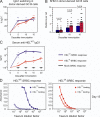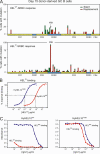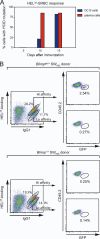High affinity germinal center B cells are actively selected into the plasma cell compartment
- PMID: 17030950
- PMCID: PMC2118125
- DOI: 10.1084/jem.20061254
High affinity germinal center B cells are actively selected into the plasma cell compartment
Abstract
A hallmark of T cell-dependent immune responses is the progressive increase in the ability of serum antibodies to bind antigen and provide immune protection. Affinity maturation of the antibody response is thought to be connected with the preferential survival of germinal centre (GC) B cells that have acquired increased affinity for antigen via somatic hypermutation of their immunoglobulin genes. However, the mechanisms that drive affinity maturation remain obscure because of the difficulty in tracking the affinity-based selection of GC B cells and their differentiation into plasma cells. We describe a powerful new model that allows these processes to be followed as they occur in vivo. In contrast to evidence from in vitro systems, responding GC B cells do not undergo plasma cell differentiation stochastically. Rather, only GC B cells that have acquired high affinity for the immunizing antigen form plasma cells. Affinity maturation is therefore driven by a tightly controlled mechanism that ensures only antibodies with the greatest possibility of neutralizing foreign antigen are produced. Because the body can sustain only limited numbers of plasma cells, this "quality control" over plasma cell differentiation is likely critical for establishing effective humoral immunity.
Figures




References
-
- Siskind, G.W., and B. Benacerraf. 1969. Cell selection by antigen in the immune response. Adv. Immunol. 10:1–50. - PubMed
-
- MacLennan, I.C., K.M. Toellner, A.F. Cunningham, K. Serre, D.M. Sze, E. Zuniga, M.C. Cook, and C.G. Vinuesa. 2003. Extrafollicular antibody responses. Immunol. Rev. 194:8–18. - PubMed
-
- Liu, Y.J., J. Zhang, P.J. Lane, E.Y. Chan, and I.C. MacLennan. 1991. Sites of specific B cell activation in primary and secondary responses to T cell-dependent and T cell-independent antigens. Eur. J. Immunol. 21:2951–2962. - PubMed
Publication types
MeSH terms
Substances
LinkOut - more resources
Full Text Sources
Other Literature Sources
Molecular Biology Databases
Miscellaneous

